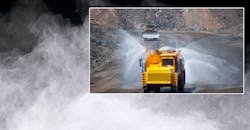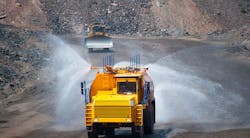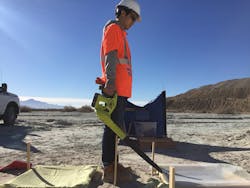A biocompatible polymer invented in the engineering labs of the University of Arizona is being commercialized as a way to control dust in arid environments and places such as mines, construction sites, and subway tunnels. Air pollution caused by dry air and blowing dust is a common and critical problem in arid climates. It affects everything from respiratory health to cars and other machinery.
To control dust in areas like mines and construction sites, the general practice is to spray the ground with water. Although this method does keep dust levels down, sites require constant reapplication, especially in arid climates such as Arizona where water can be scarce.
An environmentally safe biocompatible polymer blend that can be mixed with water and applied with existing equipment provides a new option for dust control.
The new polymer—a blend, actually—gets added to water sprayed on the ground for dust control, and it keeps the ground damp for more than two months, even when exposed to the open desert air. Through Tech Launch Arizona, the UA office that commercializes inventions stemming from research, the university is providing funds to advance the invention, protect the intellectual property, and license it to startup Clean Earth. The polymer is biocompatible and safe for human consumption, and is well-suited for use in mining facilities, but could also be used in cities, counties, and farming communities—basically, any environment where dust control is needed.
Another attractive feature of the polymer is that it can be applied using existing technologies and machinery. The new material can be mixed with water and applied using today’s water tank trucks and spraying techniques.
Materials science and engineering doctoral student Taehee Lee uses a blower to create a 25-mph wind to measure generated dust concentrations where dust suppressants were applied two weeks prior. (Courtesy: Minkyu Kim)
There seems to be a particularly strong demand for the product in South Korea ,where recent legislation limits the amount of dust industries such as coal power plants can emit. If they are caught going over their limit, the industry must lower their emission rates or pay high fines. So, if they those industries do not get their polluting under control, they could be shut down. South Korean officials also plan on using the product to reduce dust levels in subway tunnels.



